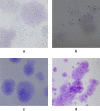A quantum-inspired classifier for clonogenic assay evaluations
- PMID: 33531515
- PMCID: PMC7854718
- DOI: 10.1038/s41598-021-82085-8
A quantum-inspired classifier for clonogenic assay evaluations
Abstract
Recent advances in Quantum Machine Learning (QML) have provided benefits to several computational processes, drastically reducing the time complexity. Another approach of combining quantum information theory with machine learning-without involving quantum computers-is known as Quantum-inspired Machine Learning (QiML), which exploits the expressive power of the quantum language to increase the accuracy of the process (rather than reducing the time complexity). In this work, we propose a large-scale experiment based on the application of a binary classifier inspired by quantum information theory to the biomedical imaging context in clonogenic assay evaluation to identify the most discriminative feature, allowing us to enhance cell colony segmentation. This innovative approach offers a two-fold result: (1) among the extracted and analyzed image features, homogeneity is shown to be a relevant feature in detecting challenging cell colonies; and (2) the proposed quantum-inspired classifier is a novel and outstanding methodology, compared to conventional machine learning classifiers, for the evaluation of clonogenic assays.
Figures


References
-
- Schuld M, Petruccione F. Supervised Learning with Quantum Computers. Quantum Science and Technology. 1. Switzerland: Springer Nature; 2018.
-
- Schuld M, Sinayskiy I, Petruccione F. An introduction to quantum machine learning. Contemp. Phys. 2014;56:172–185. doi: 10.1080/00107514.2014.964942. - DOI
-
- Wittek P. Quantum Machine Learning: What Quantum Computing Means to Data Mining. 1. Cambridge: Academic Press; 2014.
Publication types
LinkOut - more resources
Full Text Sources
Other Literature Sources

